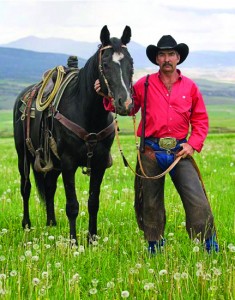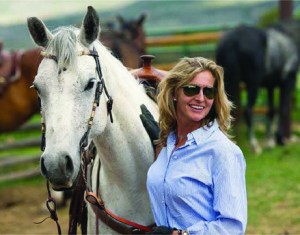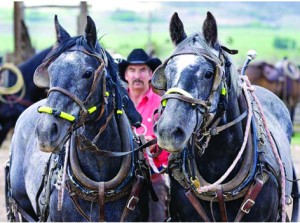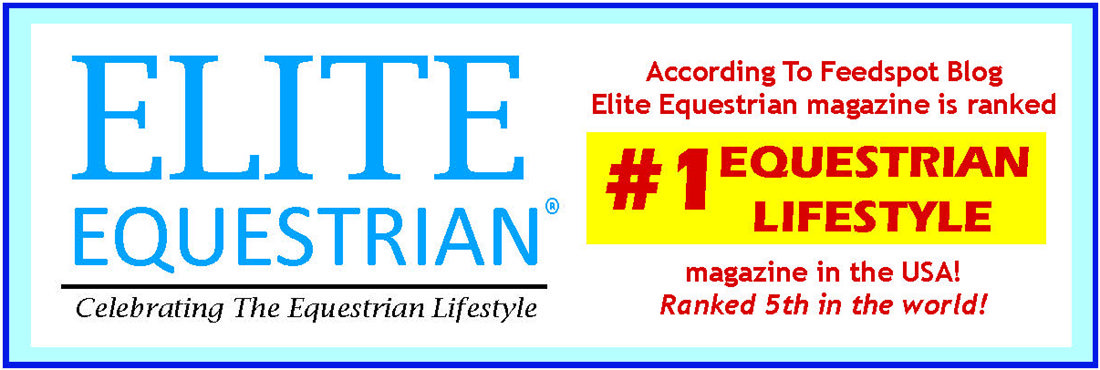
Kip Gates and the Australian Stock Horse Society
It’s a warm June afternoon at the Gates Ranch, a remote cattle outfit located high in the Rocky Mountains of Colorado; a one-hour drive northwest of the resort town of Vail. Jagged, snowcapped peaks pierce the horizon, jutting into an azure sky. The white noise of the rushing Colorado River emanates from a nearby canyon.

A dull staccato – the hoofbeats of dozens of horses – builds steadily from a faint suggestion of a whisper, rising in volume until it competes with, then overwhelms, the distant sound of whitewater rapids. At last, a herd of dark-colored horses tops a crest and spills onto an impossibly green mountain pasture. The herd is trailed by a fast-moving group of riders led by the ranch’s owner, Kip Gates, his bright red shirt standing out against the landscape. It’s a ‘Marlboro Man Moment’, with the requisite elements – horseback cowboys at work against the backdrop of an unmistakably Western panorama – with one wild card: the lineage of the running herd and the saddle horses in pursuit. Rather than the nearly ubiquitous Quarter Horses (or any of their many derivatives) one might expect to find on a North American ranch, these horses are sons and daughters of the United States’ first Australian Stock Horse breeding stallion, the animal Kip believes might just change the shape of the U.S. horse market.
The Australian Stock Horse traces its roots to the 18th century, and the importation of Thoroughbred, Spanish and Arabian horses, as well as Timor and Welsh Mountain ponies, to the island continent. In the early 19th century, Thoroughbred imports to Australia surged. Thoroughbred stallions crossed on hardy Australian stock, derived from those earlier imports, produced lean, tough horses that came to be known first as ‘Walers’ (given that the horses emanated, in large part, from the Australian province of New South Wales), then as Australian Stock Horses. The breed became the horse of choice for the young country’s settlers, stockmen and military. Today, Australian Stock Horses are used on ranches (or stations, as they’re called ‘Down Under’) and in all manner of equestrian competition. The breed’s registry, the Australian Stock Horse Society (ashs.com.au), formed in 1971, has registered more than 170,000 horses. Kip Gates first encountered the breed in 2001, when he traveled to Australia to compete in the ‘Man from Snowy River Challenge’, a decathlon of equestrian events inspired by the 1982 film The Man from Snowy River. The Challenge’ includes a series of harrowing cross-country courses, as well as uniquely Australian offerings such as a wild-brumby (feral horse) catch and a horseback whip-cracking competition. Each rider competes aboard one horse for the duration of the three-day event. When Kip – the Challenge’s first non-Australian competitor – arrived, event organizers had six Australian Stock Horses waiting for him to test. “I asked to look at horses that were broke to ride, nothing more,” he says. “I wanted to prep my Challenge horse myself, so we’d be used to one another.” The Stock Horses handpicked for Kip were lean, Thoroughbred-like animals. As he worked with the group – sorting cattle, taking them over jumps, and eventually winnowing the group down to the horse he’d use in competition – Kip was awestruck by the breed. “They were leaner

than Quarter Horses, with smaller hips and shoulders sloped at not quite a 45-degree angle,” he says. “They could reach out farther, and seemed to walk twice as fast as my horses at home. And, they were calm, gentle and versatile.” Kip’s appreciation for the breed grew when, despite breaking his collarbone on the Challenge’s first day, he finished the competition ranked 25th out of 60 contestants. Kip began imagining using Stock Horses on his Colorado ranch, and crossing a Stock Horse stallion on his Quarter Horse mares. The result, he thought, might be the perfect horse for use in the rugged wilderness on which his family ran cattle. “I wanted to see more of these horses,” he says. “I began researching Stock Horse pedigrees, and visited horse farms in the Snowy Range, between Sydney and Melbourne. While visiting Nioka, a Stock Horse operation owned by breeder Bill Scott, Kip encountered a black 3-year-old colt named Stockman’s Swagman, by Kyabra Radium
Abbey, one of the breed’s top sires of winners in stock, Western and hunt-seat events. The colt was prototypical of the Stock Horse breed; more than 16 hands tall and muscularly lean, with hints of Thoroughbred and Arabian, but an undeniable toughness that would allow for a long day’s work under saddle. Kip made an offer on “Swagman,” but Bill wouldn’t sell. Kip returned home and, undaunted by Bill’s initial lack of interest, corresponded with the Australian breeder for the next year. When Kip returned to Australia for the 2002 Man from Snowy River Challenge – at which he finished in 16th place – the two men struck a deal and Kip purchased the colt. Three-and-a-half weeks later, following quarantines in Melbourne and Los Angeles, Swagman—the first Stock Horse breeding stallion exported to the United States – arrived at the Gates Ranch.
The Gates family homesteaded in the Colorado Rocky Mountains in 1880. Kip represents the fifth generation of stockmen to run cattle and horses on the outfit. It’s challenging, up-and-down country, better than 8,000 feet above sea level at the ranch headquarters. Summers are mild, sunny and short; winter weather – or at least the potential for it – is on offer from September through May. Each June, the ranch’s herd of grass-fed Angus is driven 15 miles to summer range on a 200,000-acre permit in the adjacent Flattops Wilderness; cattle are sorted and brought back to winter range in September.
All work is done from horseback, in country where horses and riders confront rimrock ledges, river crossings, downed timber and steep slopes on a daily basis. “I don’t start my colts until they’re 3 because I want to be sure they’re developed and can handle this terrain,” Kip says. “Until then, I run them in a canyon that cuts through the ranch. Day-to-day, they have to go over rocks and logs, through creeks. By the time I bring them out of the canyon, they’re already mountain horses.” Since 1976, the year he graduated from college, Kip has operated an outfitting business, basing it out of the ranch’s headquarters. Ranch horses pull double-duty as hunting mounts, carrying hunters deep into the Flattops, to elevations as high as 14,000 feet, in search of deer, elk and mountain lion. “We pack people into nine camps,” Kip explains. “There are no roads to any of

them, so the only way in is on horseback.” Swagman’s first foal crop hit the ground in 2003. There are now 30 head of Swagman-sired Stock Horse-Quarter Horse crosses – mostly fillies, mostly black – in use as working saddle horses on the ranch. The horses have proven to be a great fit for Kip’s mountain operation. “Swagman’s colts will do anything you need – jump over logs, cross streams, work cattle, pack salt, pack hunters, pack game,”
Kip says. “He’s a total gentleman, and he throws that disposition into his colts.”
As Kip talks about Swagman and the horse’s American offspring, energy builds within him, the extra wattage burning itself off through increasingly emphatic gestures, an ever-broadening smile, and the fidgeting of a man who can hardly wait for the next ride aboard one of his horses. A reluctant ambassador for the breed he is not. Kip’s ambitions include importing from Australia two handpicked, full-blooded Stock Horse mares, crossing them with his stallion, then breeding the resulting full-blooded Stock Horse mares to a Quarter Horse stallion, further customizing his own Stock-Quarter cross. “I think the Stock Horse can have a big influence on the U.S. horse market,” he says. “I want to get them into rodeo competition. When people see what these horses can do, there will be a market.” Kip’s wife, Leslie, competed for years in hunter-jumper shows, earning several championships on the ‘A’ Circuit. “Stock Horses are beautiful under huntseat saddle,” she says. “I’m still in touch with the hunt-seat scene on the Colorado Front Range. I want to pique that crowd’s interest when these horses are ready to go.” Kip has, so far, refrained from actively marketing his half-Stock Horses. His reluctance comes from a respect for the Stock Horse breed and a desire to see it get a fair commercial launch in North America. “I’ll never sell any of my Stock Horse colts until I have them trained,” he says. “I don’t want anyone buying a horse of this breed, then picking it apart because the horse wasn’t trained. I’ll train them, and then we’ll market them. My worst problem is that I fall in love with them and don’t want to get rid of them.”

Many of these horses, frolicking in the snow on Gates Ranch, are the offspring of ‘Swagman’.
Kip Gates is the president of the Australian Stock Horse Society, US branch. ASHSUS has been in operation for one year and is the first branch outside Australia to take on this responsibility to represent the Stockhorse breed. Kip and his organization are dedicated to “….. informing horse lovers of this incredible breed.”
WHAT IS AN AUSTRALIAN STOCK HORSE?
The following description has been prepared by Peter and Jeanette Gower as a “Standard of Excellence”:
The Australian Stock Horse is a special type of saddle horse – not all saddle horses make good Stock Horses, but all good Stock Horses are top saddle horses. Above all else the Australian Stock Horse is an athlete, unmistakably blood-horse, with a generous desire to work, averaging 15 – 15.2 hands. He is highly adaptable, and smart, capable of handling himself well at speed. Like a well trained sheepdog, he enjoys action, but does not use his energy until asked. His nature and courage is truly incredible – he easily develops a close bond with his human caregiver, and when put to the test will often give more than it is thought possible under extraordinary circumstances.
For more information visit www.ashs.com.au.



